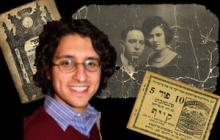Professor Devin Naar of the Department of History was recently interviewed for a feature article in the March 2014 edition of Columns: The University of Washington Alumni Magazine. There, he describes his own journey which began when he came into possession of a stack of old letters from relatives who had lived in Greece during the Second World War and were murdered during the Holocaust. It was the process of decyphering these letters--written in Ladino, the centuries-old Judeo-Spanish language of the Sephardic Jews--that set Naar on the path that would later lead him to his present task, leading a project dedicated to keeping the Sephardic language and culture alive. As the article explains:
Ladino was originally spoken by the Jews expelled from Spain in 1492. When they migrated elsewhere, especially to what was then the Ottoman Empire, the language became a rich mixture of antiquated Spanish, Hebrew, Arabic, Turkish, Greek and other languages. As most Ladino-speaking Jews assimilated into other cultures or perished during the Holocaust, Ladino nearly died out.
As Naar taught himself the language and immersed himself in the history of his own family and the Jews of Salonica, Greece, he realized that he was in a position to prevent this linguistic and cultural knowledge from being lost forever. In 2012, he launched Seattle Sephardic Treasures, part of the larger UW Sephardic Studies Program coordinated by the professor to preserve Sephardic traditions and culture.
The project took off when Naar moved to Seattle to teach at the UW in 2011. Uniquely, Seattle is home to a substantial population of Sephardic Jews, and the city has two Sephardic synagogues. Just a fraction (about 5 percent) of Jews who immigrated to the U.S. between the 1880s and the 1920s were Ladino-speaking Sephardic Jews, many of whom chose Seattle as their final destination to take advantage of the city's coastal industries.
From the first fish vendors at Pike Place Market to the patrons of Benaroya Hall, Sephardic Jews have made a significant imprint on Seattle, which Naar calls a microcosm of the Sephardic-American world.
"When I arrived, people started bringing me Ladino books and letters that they couldn't read themselves," he says. "Then they started bringing me more things—a stack of documents here, a pile of books there."
Inspired by the community's interest, Naar made an explicit call for Ladino documents. The response was overwhelming. Seattle Sephardic Treasures has now collected more Ladino books than are housed in the Library of Congress or Harvard University. Eventually, Naar hopes to upload audio recordings—some of which are more than 70 years old—to provide students, scholars and community members with an online resource for learning Ladino.
Click here to learn more about Ladino, the history of Salonica, Greece, and Devin Naar's project to preserve the language and culture of Sephardic Jews.
Devin Naar is an Assistant Professor of History and holds the UW's Marsha & Jay Glazer Chair in Jewish Studies housed in the Henry M. Jackson School of International Studies.
